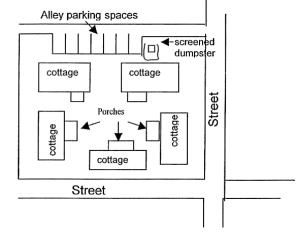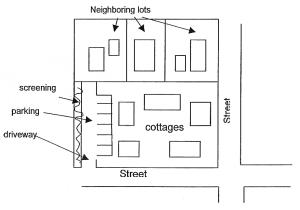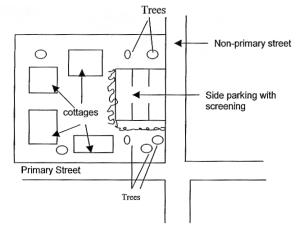Chapter 17.34
COTTAGE HOUSING DEVELOPMENT DESIGN STANDARDS
Sections:
17.34.020 Applicability, application process, and design review.
17.34.030 Density, number of cottage housing units and minimum lot area.
17.34.040 Existing nonconforming structures and accessory dwelling units.
17.34.070 Covered main entry porches.
17.34.080 Street facing facades.
17.34.100 Impervious surface area – R-I zone limitation.
17.34.120 Yards – Building setbacks from exterior lot lines.
17.34.130 Cottage housing development building separation.
17.34.170 Stormwater low impact development techniques.
17.34.190 Exterior lighting and heating/cooling equipment noise.
17.34.210 Ownership and residential use of cottages.
17.34.220 Alternative site design.
17.34.010 Purpose and intent.
The general purposes of the cottage housing development design standards are as follows:
A. A cottage housing development is an alternative type of detached housing providing small residences for households. Cottage housing is provided as part of the city’s overall housing strategy which intends to encourage affordability, innovation and variety in housing design and site development while ensuring compatibility with existing neighborhoods, and to promote a variety of housing choices to meet the needs of a population diverse in age, income, household composition and individual needs.
B. The cottage housing development design standards contained in this section are intended to create a small community of cottages oriented around open space that is pedestrian-oriented and minimizes the visibility of off-street parking. These design standards are intended to ensure that cottage housing developments include pedestrian amenities and take advantage of existing natural features on the site including topography and vegetation. The cottage housing development design standards are intended to maintain traditional cottage amenities and proportions and ensure that cottage housing developments contribute to the overall community character. Because there may be alternative designs that meet the objectives of the design standards, Chapter 17.46 PTMC provides an alternative design review process to consider other acceptable ways to accomplish the objectives of this section.
C. Cottage housing may allow higher residential density than is normally allowed in the underlying zone district. This increased density is possible through the use of smaller than average home sizes, clustered parking, and site design standards.
D. All cottage housing developments are subject to current city stormwater standards and shall incorporate stormwater low impact development techniques whenever possible. (Ord. 3306 § 1 (Exh. M), 2023; Ord. 2864 § 3, 2004).
17.34.020 Applicability, application process, and design review.
Applicability of this section, application procedure and the process for design review is pursuant to Chapter 17.46 PTMC. (Ord. 2864 § 3, 2004).
17.34.030 Density, number of cottage housing units and minimum lot area.
A. In cottage housing developments the permitted densities shall be as follows:
|
Zoning District |
R-I Low Density Residential |
R-II Medium Density Single-Family |
R-III Medium Density Multifamily |
|---|---|---|---|
|
Maximum Cottage Density |
1 cottage dwelling unit per 5,000 sf |
1 cottage dwelling unit per 1,500 sf |
1 cottage dwelling unit per 1,500 sf |
|
Minimum number of cottages per cottage housing development |
2 |
3 |
4 |
|
Maximum number of cottages per cottage housing development |
8 |
12 |
14 |
|
Minimum lot size |
10,000 sf |
5,000 sf |
5,000 sf |
B. Projects that exceed the above maximums must be processed as planned unit developments per Chapter 17.32 PTMC. (Ord. 3306 § 1 (Exh. N), 2023; Ord. 3247 § 1 (Exh. E), 2020; Ord. 2864 § 3, 2004).
17.34.040 Existing nonconforming structures and accessory dwelling units.
A. On a lot to be used for a cottage housing development, an existing detached single-family residential structure, which may be nonconforming with respect to the standards of this chapter, shall be permitted to remain, but the extent of the nonconformity may not be increased. Such nonconforming dwelling units shall be included in the maximum permitted cottage density.
1. Nonconforming dwelling units may be modified to be more consistent with this chapter. For example, roof pitches may be increased consistent with PTMC 17.34.050, but the building ground floor or total floor area may not be increased greater than permitted by PTMC 17.34.110.
B. New accessory dwelling units (ADUs) are not permitted in cottage housing developments. All residential units in a cottage housing development count towards the maximum permitted density. An existing attached or detached ADU that is accessory to an existing nonconforming single-family structure may be counted as a cottage unit if the property is developed subject to the provisions of this chapter. (Ord. 2864 § 3, 2004).
17.34.050 Building height.
A. Objective. Structures in cottage housing developments shall be designed to be single story or single story plus a loft. Because the base density is higher and building separation less than on typical residential lots, it is important to maintain a feeling of adequate light and open space by providing more restrictive maximum roof heights and roof proportion standards.
1. The maximum building height permitted for structures in cottage housing developments shall be 18 feet.
2. The highest point of a pitched roof may extend up to 23 feet. (Ord. 2864 § 3, 2004).
17.34.060 Exterior trim and roof eaves.
Repealed by Ord. 3306. (Ord. 2864 § 3, 2004).
17.34.070 Covered main entry porches.
A. Objective. All residences in cottage housing developments shall be provided with a covered main entry porch to create a private outdoor space protected from the weather and provide a transition from the interior private residential space to the semi-private outdoor space. Covered porches shall be usable both in design and dimension.
1. Cottage homes shall have a covered main entry porch with a floor area measuring at least 60 square feet in size.
2. The floor of the covered main entry porch shall have minimum dimensions of not less than five feet in any direction (length or width). (Ord. 2864 § 3, 2004).
17.34.080 Street facing facades.
A. Objective. The street facing facades of cottages in a cottage housing development will contribute to the neighborhood by including attractive design details such as windows, changes in materials, and views of front doors or porches. The main entries of some cottages will be visible from the adjacent streets to provide a visual pedestrian connection with the surrounding neighborhood.
1. All cottages shall have street facing facades that avoid blank walls or appear to “turn their backs” to the street. All cottages shall include one or more of the following on-street facing facades:
a. Changes in exterior siding material and paint color;
b. Windows which may include bay windows; and/or
c. Building modulation with a depth measuring at least one foot.
2. At least one cottage shall have its front main entry door and/or front porches visible from each street frontage. (Ord. 2864 § 3, 2004).
17.34.090 Lot coverage area.
A. Objective. Cottage housing developments shall not exceed underlying lot coverage standards for the respective zoning district to maintain residential neighborhood character and the balance of built structures to open spaces.
1. The maximum lot coverage permitted for all structures in cottage housing developments shall not exceed the requirements for the underlying zoning district contained in Table 17.16.030. (Ord. 2864 § 3, 2004).
17.34.100 Impervious surface area – R-I zone limitation.
A. Objective. Cottage housing developments located in the R-I zones shall limit their impervious surface area in recognition of the stormwater and soil conditions present in the R-I zone and to prevent adverse stormwater impacts.
1. Cottage housing developments in the R-I zoning district shall be limited to an impervious surface area of 40 percent of the total site area (excluding rights-of-way).
2. The use of paver stones, pervious pavement, grass-crete, or other types of low impact stormwater development techniques are encouraged for walkways and parking areas. (Ord. 2864 § 3, 2004).
17.34.110 Cottage floor area.
A. Objective. Structures in cottage housing developments shall be designed to be single story or single story plus a loft. Maintaining the maximum square footage of residences in cottage housing developments is necessary to prevent overbuilding of the site and to not exceed available off-street parking.
1. The maximum ground floor area for an individual principal structure in a cottage housing development shall be as follows:
a. The ground floor area may be up to 800 square feet.
b. The net total floor area of each cottage shall not exceed one and one-half times the area of the main level. (Ord. 3306 § 1 (Exh. P), 2023; Ord. 2864 § 3, 2004).
17.34.120 Yards – Building setbacks from exterior lot lines.
A. Objective. Exterior lot line building setbacks in cottage housing developments are based upon setbacks in the R-II zoning district. These yard setbacks are appropriate based upon the allowed density of cottage housing as well as the small size of the structures. Flexible setbacks are allowed per the discretion of the PCD and public works directors to obtain improved site design and to avoid impacting existing physical features on the site such as trees.
1. Front yard and street side yard on corner lots shall be 10 feet:
a. Exception. The PCD director in consultation with the public works director may authorize the setback averaging from the public right-of-way. In such cases the setback average shall be 10 feet and at no point less than five feet where the location of all structures, landscaping and other improvements will not conflict with future improvements in the right-of-way. Fences may not be placed in the right-of-way and are subject to Chapter 17.68 PTMC.
2. Rear Yard Building Setback. The minimum rear yard shall be five feet.
3. Side Yard Building Setback – Interior Lot Lines. The minimum side yard setback shall be five feet for interior lot lines. (Ord. 3306 § 1 (Exh. Q), 2023; Ord. 2864 § 3, 2004).
17.34.130 Cottage housing development building separation.
A. Objective. Structures within cottage housing developments shall observe minimum setbacks from other cottage housing development structures to avoid overcrowding the site and to maintain a sense of privacy within the cottages themselves.
1. All buildings within a cottage housing development shall maintain a minimum separation of 10 feet from cottages within a cottage housing development measured from the nearest point of the exterior walls. Accessory buildings shall comply with building code requirements for separation from noncottage structures. (Ord. 2864 § 3, 2004).
17.34.140 Common open space.
A. Objective. Open space that is commonly owned by all members of a cottage housing development is an important feature of any site design. It is intended that the open space be adequately sized and centrally located.
1. Common Open Space. A minimum of 400 square feet per cottage unit of common open space is required. Parking areas, yard setbacks, spaces between buildings of 10 feet or less in width, private open space, and driveways do not qualify as common open space.
2. Proximity to Common Open Space.
a. At least 50 percent of the cottage units shall abut a common open space, all of the cottage units shall be within 60 feet walking distance measured from the nearest entrance of the cottage along the shortest safe walking route to the nearest point of the common open space. The common open space shall have cottages abutting at least two sides.
b. For the purposes of cottage housing, “common open space” shall be the central space that may be used by all occupants of the cottage complex. (Ord. 3306 § 1 (Exh. R), 2023; Ord. 2864 § 3, 2004).
17.34.150 Private open space.
A. Objective. Each residential unit in a cottage housing development shall be provided an area of private open space. The private open space shall create a sense of privacy and shall be oriented to take advantage of solar orientation and other natural features to create a small but pleasant private yard area. The private open space may be separated from the common open space with a small hedge, picket fence, or other similar visual separation to create a sense of separate ownership.
1. Each cottage unit shall be provided with a minimum of 200 square feet of usable private open space.
2. No dimension of the private open space shall be less than eight feet. (Ord. 3306 § 1 (Exh. S), 2023; Ord. 2864 § 3, 2004).
17.34.160 Tree conservation.
A. Objective. Cottage housing developments shall be designed to incorporate existing trees to the extent possible. New trees shall be located to create amenities in the common open space, private open space, provide shade where appropriate, to create separation between buildings when desired, and to screen and soften the perimeter of parking areas and street facing sides of cottage housing developments.
1. Preservation of existing trees, and/or new trees, shall be provided consistent with Chapter 19.06 PTMC, Article III, Standards for Tree Conservation. Native trees and other vegetation shall be preserved to the extent possible and the overall site design shall take advantage of the location of existing trees as well as natural openings or clearings on forested sites. (Ord. 2864 § 3, 2004).
17.34.170 Stormwater low impact development techniques.
A. Objective. Cottage housing developments shall be designed to take advantage of open space and landscaped features to utilize stormwater low impact development techniques including natural filtration and on-site infiltration of stormwater.
1. Low impact development techniques for stormwater management shall be used wherever possible. Such techniques may include the use of pervious pavers in parking areas and for walkways, directing roof drains and parking lot runoff to landscape beds, green or living roofs, and the use of rain barrels.
2. In the R-I zone, cottages shall be located so as to maximize natural stormwater functions. In this zone, cottages shall be clustered and parking areas shall be located to preserve as much contiguous, permanently undeveloped open space and native vegetation as possible. (Ord. 2864 § 3, 2004).
17.34.180 Off-street parking.
A. Objective. Off-street parking space requirements for cottage housing developments shall be less than normally required for detached single-family residences. These reduced standards are based upon the cottages being smaller than average detached single-family homes and on average containing fewer occupants. Off-street parking shall be located and designed to be less visible from frontage streets than the cottages themselves. Off-street parking shall be designed to maintain a pedestrian character for the overall cottage housing development. Clustering parking to the side or rear of a cottage project will most often best accomplish these goals. However, on a site-specific basis, design solutions other than clustering may be found to meet this objective through the alternative design process. Parking areas shall be attractively landscaped to screen parking from adjacent properties and street rights-of-way and shall meet applicable parking lot landscape standards.
1. Repealed by Ord. 3306.
2. Off-Street Parking Location. Parking shall be located on the cottage housing development property. Off-street parking lots shall be located to the side or rear of the cottage housing development (see illustrations below). Subject to the site design administrative review approval process, parking may be adjacent to cottage units. Parking lots shall not be located between the cottage housing development and the primary street frontage.
a. Off-Street Parking Screening. Off-street parking may be located in or under a noncottage parking structure (such as a single or multi-auto carport or garage), but such structures shall not be attached to individual cottages. Uncovered parking is also permitted; provided, that off-street parking shall be screened from direct street view from one or more street facades by garage doors, or by a fence and landscaping.
b. Preferred locations for parking, in descending order of preference, are as follows:
i. To the rear of cottage housing units accessed by an alley. 
ii. To the side of the cottage housing units access by a private driveway.
iii. Parking on the side (nonprimary street) screened from the side street by either garage doors, landscaping, and/or fencing. 
c. Parking Lot Landscaping. Parking lot landscaping shall comply with the requirements of PTMC 17.72.190. (Ord. 3306 § 1 (Exh. T), 2023; Ord. 2864 § 3, 2004).
17.34.190 Exterior lighting and heating/cooling equipment noise.
A. Objective. Cottage housing developments should be designed to minimize light and noise impacts both within the development and to adjacent properties.
1. Where provided, exterior lighting shall be mounted as low as possible, pointed downward, and the light source shall be shielded from direct observation from above, adjacent properties, and public rights-of-way. Lighting “spillover” to adjacent properties shall be avoided.
2. Heating (and cooling, if applicable) equipment for cottage housing developments shall be designed to cause little or no noise impacts within the development and to adjacent properties. (Ord. 3306 § 1 (Exh. U), 2023; Ord. 2864 § 3, 2004).
17.34.200 Required separation of cottage housing developments in the R-I and R-II zoning districts.
Repealed by Ord. 3306. (Ord. 2864 § 3, 2004).
17.34.210 Ownership and residential use of cottages.
A. All cottage housing developments shall be developed utilizing the procedures of Chapter 18.22 PTMC, Unit Lot Subdivisions, or Chapter 18.20 PTMC, Binding Site Plans, except that an association, cooperative or other similar ownership technique may be substituted for the requirement of residential condominiums. Appropriate documentation of formal legal ownership of the development shall be recorded with the Jefferson County auditor’s office.
B. Cottages are for residential use only and may not be operated as transient accommodations. (Ord. 3306 § 1 (Exh. W), 2023; Ord. 2864 § 3, 2004).
17.34.220 Alternative site design.
It is possible that an alternative design may fulfill the intent of this chapter while not complying with the provisions herein. Requests for alternative designs shall be processed administratively. Committee review shall be available at the developer’s request. (Ord. 3306 § 1 (Exh. X), 2023; Ord. 2864 § 3, 2004).


